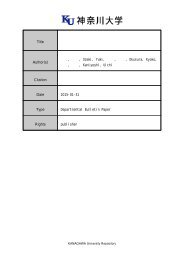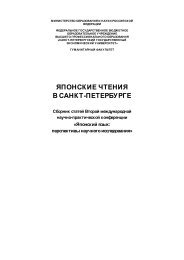to Learners with Special Educational Needs
e-textbook SEN
e-textbook SEN
Create successful ePaper yourself
Turn your PDF publications into a flip-book with our unique Google optimized e-Paper software.
Pokrivčáková, S. et al. (2015). Teaching Foreign Languages <strong>to</strong> <strong>Learners</strong> <strong>with</strong> <strong>Special</strong> <strong>Educational</strong> <strong>Needs</strong>:<br />
e-textbook for foreign language teachers. Nitra: Constantine the Philosopher University. 128 p.<br />
ISBN 978-80-558-0941-0<br />
understanding <strong>with</strong> the aim <strong>to</strong> au<strong>to</strong>matize using because the pupils need not know grammatical<br />
rules in initial stages of FLL – in the communicative level. The expressions must be selected <strong>with</strong><br />
respect <strong>to</strong> concrete situation in a given group/class – the pupils should know the words from a<br />
practice and can name them in their mother <strong>to</strong>ngue and/or in a language of education (Slovak,<br />
Hungarian).<br />
Teaching and learning materials (i.e. educational materials) selection is also bounded <strong>with</strong><br />
the above presented items. These mean not only text-books and work-sheets but also all<br />
accessory items which can be and are (usually) used in course of the lessons. They help <strong>to</strong> make<br />
teacher´s work effective and at the same time they enrich educational process and facilitate<br />
pupils´ comprehension.<br />
These materials can be found as components of regular published equipment. To prepare<br />
fitted materials is a challenge for creative teachers because it means <strong>to</strong> find sources in internet,<br />
<strong>to</strong> adapt and combine them, or create new sheets, texts, exercises, games etc.<br />
Real objects, <strong>to</strong>ys, things of daily handling and other materials form a very important part of<br />
educational aids. They are useful especially for young pupils and for various types of thinking<br />
(e.g. visual and kinaesthetic types, see below). Frequent repetition in different contexts helps <strong>to</strong><br />
fix information.<br />
The use of concrete materials, continuous and developing repetition of presented matters and<br />
gradual involvement of advanced information (globally said) must be present during the whole<br />
FL education <strong>to</strong> prevent failure, frustration from individual troubles and insufficiencies.<br />
In later phase, after mastering the basic knowledge, pupils can proceed <strong>to</strong> higher stage in FL<br />
learning. Reading and writing, as further language skills, can be involved and developed in<br />
similar though adapted, activities and materials – (reading) texts, pictures, objects, music, games<br />
can stimulate formulation of sentences.<br />
<strong>Special</strong> procedures of FL teaching of pupils from MRC are needed in primary level but also in<br />
later grades. Requirement <strong>to</strong> reach expected level according <strong>to</strong> CEFRL (internet source, see<br />
below) which were set <strong>to</strong> A1-A2 for basic school, must be judged carefully as these criteria were<br />
defined for adult learners and just little adopted for younger ones in Slovak translation.<br />
For all age groups of pupils from MRC in basic schools can be recommended methods as<br />
follows:<br />
1. CLIL (Content and Language Integrated Learning) – for introducing English/FL in various<br />
contexts of non-linguistic subjects, more frequent contact <strong>with</strong> FL, possibility <strong>to</strong> arrange more<br />
interesting situations for pupils;<br />
2. Personalized learning – for preparing opportunities of individual engagement in a way that<br />
is close <strong>to</strong> his/her experiences, a chance <strong>to</strong> present own opinions and attitudes;<br />
3. TPR (Total Physical Response) – enables more dynamic lessons where children can express<br />
freely keeping their attention and concentration <strong>to</strong> selected/intended content <strong>with</strong>out<br />
emphasizing the learning situation.<br />
Topics and activities (optional) in primary FLL for pupils from MRC:<br />
The beginning of FL lessons or introducing new vocabulary and activities must be preceded<br />
by talking about an on-coming <strong>to</strong>pic and situation in the language of education, eventually in<br />
Roma language <strong>with</strong> a help of teacher´s assistant. The aim is <strong>to</strong> prepare and motivate pupils for<br />
the subsequent and wished procedures.<br />
The initial vocabulary is connected <strong>to</strong> school and class activities and forms a part of class<br />
instructions, e.g. sit, stand, book, paper, pencil, pen; new expressions are always presented<br />
followed by manifestation of real objects and acts. This is probably not enough for<br />
understanding and using Slovak words is inevitable.<br />
Family – members and some main/usual activities (e.g. sleep, eat, sit, watch TV); later:<br />
occasional activities – holidays, birthday (event. names of holidays, present, sweets);<br />
Home and the closest surrounding – selection of terms depends on local conditions (e.g.<br />
village/ <strong>to</strong>wn, forest, river, hill/-s, street, house, flower, tree);<br />
113






